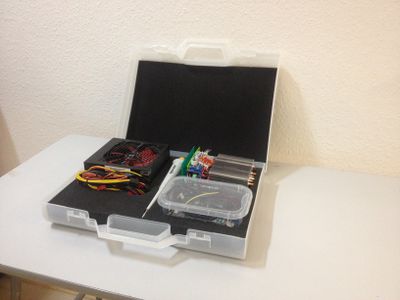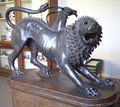Cloning discourse
The "How I prepare myself for being cloned" toolkit (Fig. 1.) dives into the very nature of the organism, which, throughout its life cycle, demonstrates the ability to self-replicate. Referring to mythological hybrids like Pegasus, centaurs, mermaids, or minotaurs, the presented toolkit explains the basics of synthetic biology and transgenic organisms. The first version of the toolkit includes a polymerase chain reaction (PCR) machine for amplification of DNA and an electrophoresis chamber for analysis of DNA.
Contents
Background
“Cloning in biotechnology refers to processes used to create copies of DNA fragments (molecular cloning), cells (cell cloning), or organisms.”(wikipedia)
“Cloning is a natural form of reproduction that has allowed life forms to spread for more than 50 thousand years. It is the reproduction method used by plants, fungi, and bacteria, and is also the way that clonal colonies reproduce themselves.[4][5] Examples of these organisms include blueberry plants, hazel trees, the Pando trees,[6][7] the Kentucky coffeetree, Myricas, and the American sweetgum.”(wikipedia)
Dolly
“Dolly, a Finn-Dorset ewe, was the first mammal to have been successfully cloned from an adult somatic cell. Dolly was formed by taking a cell from the udder of her 6-year old biological mother. Dolly's embryo was created by taking the cell and inserting it into a sheep ovum. .. The embryo was then placed inside a female sheep that went through a normal pregnancy. She was cloned [in 1996] at the Roslin Institute in Scotland.”(wikipedia, https://en.wikipedia.org/wiki/Cloning)
“Dolly was publicly significant because the effort showed that genetic material from a specific adult cell, programmed to express only a distinct subset of its genes, can be reprogrammed to grow an entirely new organism. Before this demonstration, it had been shown by John Gurdon that nuclei from differentiated cells could give rise to an entire organism after transplantation into an enucleated egg.”(wikipedia, https://en.wikipedia.org/wiki/Cloning)
“Reproductive cloning generally uses "somatic cell nuclear transfer" (SCNT) to create animals that are genetically identical. This process entails the transfer of a nucleus from a donor adult cell (somatic cell) to an egg from which the nucleus has been removed, or to a cell from a blastocyst from which the nucleus has been removed.”(wikipedia, https://en.wikipedia.org/wiki/Cloning)
Transgenic organisms
Genetically modified organisms or “Transgenic organisms are able to express foreign genes because the genetic code is similar for all organisms. This means that a specific DNA sequence will code for the same protein in all organisms. Due to this similarity in protein sequence, scientists can cut DNA at these common protein points and add other genes. An example of this is the "super mice" of the 1980s. These mice were able to produce the human protein tPA to treat blood clots.”
mythological hybrids
Pegasus, Centaur, mermaids, Minotaur. “In mythology, folklore and speculative fiction, shapeshifting, or metamorphosis is the ability of an entity to physically transform into another being or form. This is usually achieved through an inherent faculty of a mythological creature, divine intervention, or the use of magic spells or talismans.”(wikipedia)
Genetic engineering
"there is a clear distinction between breeding and genetic engineering. Breeders manipulate indirectly the natural processes of gene selection and mutation that occur in nature. Breeders are unable, therefore, to turn genes on or off with precision or to create hybrids with genomic material so distinct as that of a dog and a jellyfish. In this sense, a distinctive trait of transgenic art is that the genetic material is manipulated directly: the foreign DNA is precisely integrated into the host genome. In addition to genetic transfer of existing genes from one species to another, we can also speak of "artist's genes," i.e., chimeric genes or new genetic information completely created by the artist through the complementary bases A (adenine) and T (thymine) or C (cytosine) and G (guanine)." (Kac 1998)
"The foreign DNA may be expressed as extrachromosomal satellite DNA or it may be integrated into the cellular chromosomes. Every living organism has a genetic code that can be manipulated, and the recombinant DNA can be passed on to the next generations." (Kac 1998)
"Among the most important tools in the genetic engineer's tool kit are enzymes that perform specific functions on DNA. .. enzymes known as ligases join the ends of two DNA fragments. These and other enzymes enable the manipulation and amplification of DNA, essential components in joining the DNA of two unrelated organisms."(Fenwick 2004)
Methods for genetically modified plants
man mischt vereinzelte Zellen mit DNA Molekülen
Agrobacterium tumefaciens (Boden Bakterien, die Bakterien kommen aus der Natur, sie greifen die Pflanzen an wenn die verletzt sind; die infizieren die Pflanzen mit DNA; damit entsteht ein Tumor/callus; durch diese Bakterien genetisch verändert werden; die Bakterien haben in der Zeit ein Gen/Bauplan für ein eiweiss, damit die pflanzen dieses Eiweiß produzieren und die Bakterien fressen da; Kwass Nahrung mittel; man nennt dieses Phänomen genetische Kolonisation). Zufall. Bakterien machen Verbindungskanäle mit Injektion von DNA. Woher kann man die DNA Teile bestimmen CRISPR/Cas9. Methode damit man ganz genau bestimmen wo die neue DNA eingebaut wird
Plant cloning HOWTO
man kann von einer Pflanze Millionen klonierten Pflanzen züchten. das wichtigste ist eine Zelle zu haben.
File:Transgenic Crops.pdf
pflanzen Blatter ins enyzm geben (Cellulase Macerozyme) enzyme kommen von microorganismen und die teilen die zellen (fressen zellenwände) zellverband zerstören und auflösen damit wir einzelne Zellen naher haben wenn das Milieu lebend/gut/günstig ist, können wir diese Zellen durch Teilung vermehren am Anfang sieht man Callus (undifferenziertes pflanzen Gewebe) man braucht bestimmte pflanzenhormonmischung um daraus Mehrstoff um ein Richtiges/siehtbares Pflanzen zu haben braucht man schon ein paar Monate. Und dafür sollte bestimmtes PH, Temperatur, Licht usw stehen Wenn da zu viele Zellen sind, muss man erst zentrifugieren/waschen damit die Zellen vereinzelt werden könnten. Um das Milieu (=Umwelt / nährlösung / Licht Temperatur / Belüftung)
Projects
GloFish
The first genetically modified animal to be sold as a pet
Revital Cohen and Tuur Van Balen, Sterile. In Sterile, albino goldfish were engineered to hatch without reproductive organs. Following a long collaboration, an edition of 45 goldfish was produced for the artists by Professor Yamaha in his laboratory in Hokkaido, Japan. The fish were not conceived as animals but made as objects, unable to partake in the biological cycle. http://www.cohenvanbalen.com/work/sterile
Eduardo Kac
GFP Bunny. http://www.ekac.org/gfpbunny.html
Eduardo Kac. Natural history of the Enigma. Edunia. "The new flower is a Petunia strain that I invented and produced through molecular biology. It is not found in nature. The Edunia has red veins on light pink petals and a gene of mine is expressed on every cell of its red veins, i.e., my gene produces a protein in the veins only [2]. The gene was isolated and sequenced from my blood. The petal pink background, against which the red veins are seen, is evocative of my own pinkish white skin tone. The result of this molecular manipulation is a bloom that creates the living image of human blood rushing through the veins of a flower." http://www.ekac.org/nat.hist.enig.html
GFP Bunny. Source: ekac.org
Edunia. Source: ekac.org
Super Cell
The project Super Cell is a fictional supermarket offering speculative products, which are all based on Synthetic Biology. The projects aims to improve public awareness about Synthetic Biology and at the same time, foster a debate on how we want to see it manifested in our everyday lives. Implications of Biotechnologies are usually discussed on a philosophical, ethical, legal or possibly religious level. https://vimeo.com/39653216 http://super-cell.org/
Cloning DNA samples
- cutting out DNA samples from different flesh sorts (sausage)
- putting samples into Eppendorf reaction tubes (Epi)
- adding buffer (1000 ul) enzyme (100 ul) in a bigger epi tube in order to prepare mix for dissolving samples
- divide 200 ul of mix into tubes with samples so it dissolves all other proteins and leaves only dna
- putting samples into heating/cooling block for one hour with 56C
One hour later
- transfer liquid to the bigger epic tubes
- adding 200 ul of lüser puffer to the dissolved samples. brakes the walls of the cell (functions as washing medium)
- adding 200 ul 100% ethanol in order to get DNA out
- transferring the liquid into the adapter tubes with powder (Ionenaustauschchromatographie)
- DIY centrifuge didn’t work (liquid was not getting through the powder); we need to find a faster solution; another solution found: we met Johannes in Fablab who offered his hand and the HU lab;
- 3 centrifuge cycles with different buffer; the last one with water in order to have dna in the final sample
- polymerase master mixer (half of the total mix; 15ul; from one dna makes more dna) + sample (10ul) + primer forward (2,5ul) + primer reverse (2,5ul)
Gel electrophorese chamber
- cutting out from plastic box
- preparing screws
- preparing 1% agarose (agarose, tne, destiled water)
- pouring agarose solution into the chamber
- cutting out endings of agarose for screws (screws get hot when letting electricity through and therefore it needs liquid outside)
- pouring the liquid (distiled water + the solution; no agarose)
- pipetting dna ladder for measurements into the first gel pocket
- pipetting samples with colouring (instead of colour one could use 40% glicerol so the samples sink into the gel pockets) into the remaining gel pockets
- waiting 40 min
References
- Ann Fenwick (2004). How Do You Make A Transgenic Plant? Available at: http://cls.casa.colostate.edu/transgeniccrops/how.html (Accessed 15 December 2015).
- Eduardo Kac (1998). Transgenic Art. Available at: http://www.ekac.org/transgenic.html (Accessed 15 December 2015)
- wikipedia (2015a). Transgenesis. Available at: https://en.wikipedia.org/wiki/Transgenesis (Accessed 15 December 2015)
- wikipedia (2015b). Shapeshifting. Available at: https://en.wikipedia.org/wiki/Shapeshifting (Accessed 15 December 2015)

















